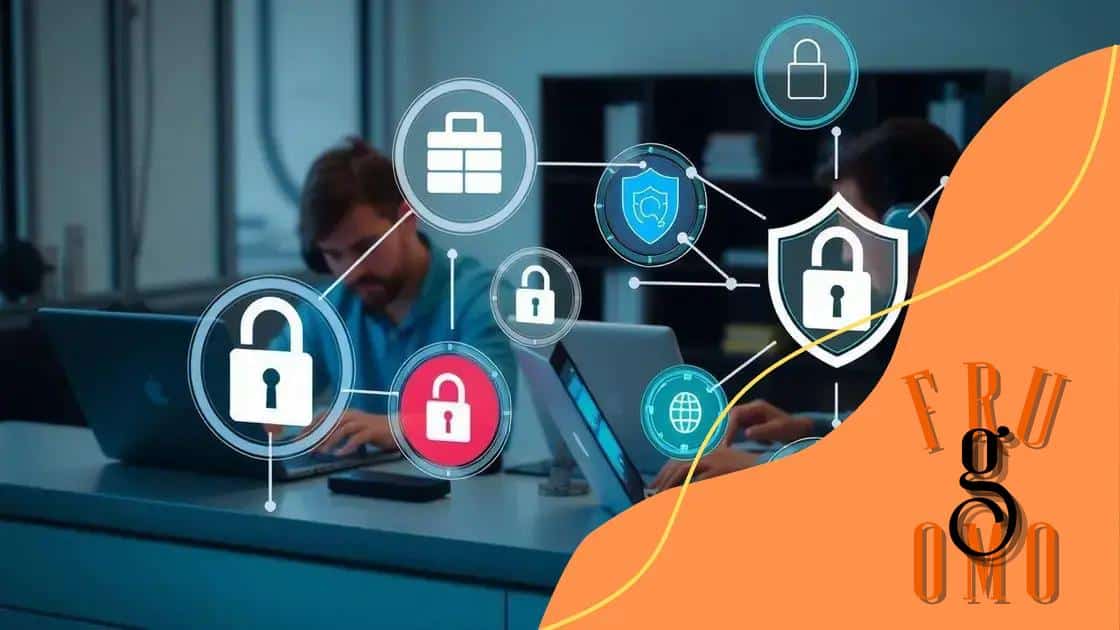Cybersecurity for remote workforces: what you need to know

Cybersecurity awareness training equips employees with the knowledge to identify threats like phishing and ransomware, implement best practices, and maintain robust security protocols in remote work environments.
Cybersecurity for remote workforces has become a pressing concern as more employees work from home. How can businesses protect their data in this new era of remote work? In this article, we’ll delve into effective strategies and tools.
Understanding the key cybersecurity threats for remote workers
Understanding the key cybersecurity threats for remote workers is vital for keeping sensitive information safe. As employees increasingly work from home, the risks associated with online activities expand. This section aims to shed light on those threats and how to combat them effectively.
Common Cybersecurity Threats
Remote workers face numerous challenges that can compromise security. Here are some of the most common risks:
- Phishing Attacks
- Malware and Ransomware
- Unsecured Wi-Fi Networks
- Data Breaches
Each of these threats can lead to severe consequences, such as financial loss or data theft. For example, phishing attacks trick employees into providing sensitive information by mimicking legitimate sources. It’s crucial to educate remote teams about recognizing these scams.
Importance of Secure Connections
Using unsecured Wi-Fi networks poses a significant risk. When employees connect to public networks, they expose themselves to potential hacking attempts. Strong security measures, such as using a Virtual Private Network (VPN), can help protect their connections.
Additionally, implementing strong password policies is essential. A good password should be complex and updated regularly. Educating employees about password hygiene is crucial in preventing unauthorized access to sensitive data.
Protecting Personal Devices
Many remote workers use personal devices for business purposes. This practice can lead to security vulnerabilities if these devices are not adequately protected. Regularly updating software and using antivirus programs can mitigate these risks. It’s also essential for employees to avoid downloading suspicious files and to be cautious when clicking on links.
By understanding these threats and incorporating robust security practices, remote teams can better protect themselves. Every employee must stay informed and vigilant against potential cybersecurity threats.
Best practices for securing remote work environments
Implementing the best practices for securing remote work environments is essential for protecting company data and maintaining productivity. As remote work becomes more common, organizations must prioritize security to ensure their operations are not compromised.
Creating Strong Passwords
One of the fundamental ways to enhance security is by creating strong passwords. Employees should use combinations of letters, numbers, and symbols. It’s advisable to change passwords regularly and avoid using the same password across multiple platforms.
- Use at least 12 characters in passwords.
- Incorporate uppercase, lowercase, numbers, and symbols.
- Utilize a password manager to help remember complex passwords.
Another best practice involves enabling two-factor authentication (2FA). This adds an extra layer of protection, requiring verification through a secondary method, such as a text message or authentication app.
Secure Internet Connections
Using secure internet connections is crucial when working remotely. Employees should avoid public Wi-Fi and use a secure network whenever possible. If necessary, they can use a Virtual Private Network (VPN), which encrypts data and protects it from prying eyes.
Regular updates to software and applications are also critical in maintaining security. Software updates often include patches for vulnerabilities that could be exploited by hackers. Encouraging employees to enable automatic updates can ensure that they stay protected without needing to remember to check manually.
Conducting Regular Security Training
Training employees on security protocols is vital for maintaining a secure remote work environment. Regularly scheduled training sessions can help employees recognize potential threats and understand the necessary steps to protect company information. These sessions can cover topics like identifying phishing emails, using secure applications, and proper handling of sensitive data.
By adhering to these best practices, organizations can foster a safer remote work culture. Security should always be a shared responsibility, and each employee plays a critical role in protecting the company’s assets.
Tools for enhancing cybersecurity in remote teams

The right tools for enhancing cybersecurity in remote teams are essential for safeguarding sensitive information. With many employees working from home, using effective technologies can significantly reduce risks and create a secure work environment.
Security Software Solutions
One of the primary tools organizations should invest in is robust security software. This includes antivirus programs, firewalls, and malware protection. These tools help detect and eliminate potential threats before they can cause damage. Additionally, some tools provide real-time monitoring to identify suspicious activities as they occur.
- Antivirus software protects against malware and viruses.
- Firewalls act as barriers between trusted and untrusted networks.
- Intrusion detection systems monitor network traffic for unauthorized access.
Another important component is a Virtual Private Network (VPN). A VPN encrypts internet traffic and helps secure remote connections. It allows employees to access company resources without exposing sensitive information to potential attackers.
Password Management Tools
Using password management tools can also enhance security. These tools help create, store, and manage complex passwords without the need to remember each one. This ensures that employees use strong and unique passwords for different accounts.
Implementing Multi-Factor Authentication (MFA) is another effective strategy. MFA requires users to provide multiple forms of verification before accessing sensitive information. This could include a password, a security token, or a biometric scan, adding an extra layer of security against unauthorized access.
Employee Training Platforms
Investing in employee training platforms is critical as well. Regular training sessions help staff stay updated on the latest cybersecurity threats and best practices. Creating awareness around phishing attacks and safe internet usage can significantly reduce the risk of human error, which is often the weakest link in security protocols.
By leveraging these tools and strategies, organizations can effectively fortify their cybersecurity measures. Security is not only about technology; it also involves creating a culture of awareness and responsibility within remote teams.
How to develop a cybersecurity policy for remote workforces
Developing a cybersecurity policy for remote workforces is crucial for protecting sensitive information and ensuring compliance with regulations. A well-defined policy helps employees understand their responsibilities and the security measures that must be followed.
Assessing Current Risks
The first step in creating a cybersecurity policy is to assess current risks. Identify potential threats that could impact remote workers, such as phishing attacks, data breaches, and insecure networks. Understanding these risks helps tailor the policy to address specific vulnerabilities.
- Analyze past incidents to identify weaknesses.
- Review current security measures to find gaps.
- Consult with IT professionals for expert insights.
Once risks are identified, creating security protocols becomes easier. These protocols can include guidelines for password management, secure file sharing, and the use of security software.
Establishing Clear Guidelines
Next, set clear guidelines within the policy. These guidelines should inform employees about best practices, such as using two-factor authentication, not accessing company data on public Wi-Fi, and regularly updating software. Providing comprehensive instructions allows remote teams to act responsibly and securely.
It’s also important to define roles and responsibilities within the organization. Designate security officers or teams responsible for enforcing the policy and responding to incidents. This accountability helps ensure adherence and fosters a culture of security.
Training and Awareness Programs
Training is another essential component of a successful cybersecurity policy. Implement regular training sessions to educate employees about potential threats and proper security measures. Engaging training sessions can enhance awareness and empower staff to recognize and report suspicious activities.
Additionally, consider developing a system for ongoing communication about cybersecurity updates. Keeping employees informed about new threats or changes to security protocols helps maintain a proactive security stance.
By developing a comprehensive cybersecurity policy that addresses risks specifically related to remote workforces, organizations can strengthen their defenses. This proactive approach promotes a secure working environment, protecting both the employees and the organization.
Training employees on cybersecurity awareness and risks
Training employees on cybersecurity awareness and risks is a vital step in any organization’s defense strategy. By educating staff about potential threats, companies can significantly reduce the risk of data breaches and cyberattacks. This training can empower employees to recognize suspicious activities and respond appropriately.
Understanding Cyber Threats
The first part of any training program should focus on helping employees understand common cybersecurity threats. These include phishing, social engineering, and ransomware. Knowing what these threats look like helps employees stay vigilant and cautious. Regular updates about evolving threats can keep this knowledge fresh and relevant.
- Phishing attacks often appear as fake emails from trusted sources.
- Social engineering tricks individuals into revealing confidential information.
- Ransomware locks users out of their systems until a payment is made.
Engaging employees in discussions about recent incidents can also be beneficial. Analyzing real-world cases fosters understanding and promotes caution within the work environment.
Implementing Best Practices
In addition to recognizing threats, training should emphasize best practices for online safety. Employees must be aware of the importance of using strong passwords, enabling two-factor authentication, and not sharing sensitive information over insecure channels. Demonstrations and practical exercises can illustrate these best practices effectively.
It’s beneficial to create a culture of security where every employee feels responsible for protecting company data. Reminders about regular updates to software and apps can also be part of the training, ensuring everyone knows to keep their tools secure.
Regular Refresher Courses
Continuous training is key in the ever-changing landscape of cybersecurity. Implementing regular refresher courses can help maintain awareness among employees. These courses can be short, interactive, and even gamified to enhance engagement.
By making cybersecurity training a routine part of the work culture, companies can foster a proactive approach to security. Employees who feel informed and involved are more likely to take security seriously and to act responsibly.
In conclusion, maintaining cybersecurity awareness and training employees is essential for safeguarding remote work environments. By educating staff about common threats, incorporating best practices, and conducting regular training, organizations can significantly reduce their risk of cyberattacks. A proactive approach fosters a culture of security, keeping both employees and sensitive data safe. Remember, cybersecurity is a shared responsibility, where every individual plays a vital role in protecting the organization’s assets.
FAQ – Frequently Asked Questions about Cybersecurity Awareness Training
Why is cybersecurity training important for employees?
Cybersecurity training is vital because it helps employees recognize threats and understand how to protect sensitive information, reducing the risk of data breaches.
What are common cyber threats employees should know about?
Employees should be aware of common threats such as phishing attacks, ransomware, and social engineering schemes to better identify and avoid them.
How often should cybersecurity training be conducted?
Training should be conducted regularly, ideally every few months, to keep employees updated on the latest threats and best practices.
What are some best practices employees can implement?
Best practices include using strong passwords, enabling two-factor authentication, and regularly updating software to enhance overall security.





